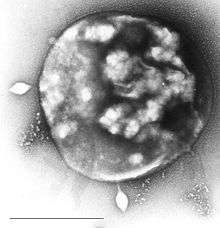Proteoarchaeota
Proteoarchaeota are a proposed archaeal kingdom thought to be closely related to the Eukaryotes.[2][3][lower-alpha 1]
| Proteoarchaeota | |
|---|---|
 | |
| Archaea Sulfolobus infected with specific virus STSV-1 | |
| Scientific classification | |
| Domain: | Archaea |
| Kingdom: | Proteoarchaeota Petitjean et al. 2014 |
| Superphyla and Phyla[1] | |
| |
Classification
The phylogenetic relationship of this group is still under discussion. The relationship of the members is approximately as follows:[4][5][6][7]
| Proteoarchaeota |
| |||||||||||||||||||||||||||||||||||||||||||||||||||||||||
Notes
- Approximately the same group is sometimes referred to as TACK after the initial letters of its early-found daughter clades: Thaumarchaeota, Aigarchaeota, Crenarchaeota, and Korarchaeota. Because of the unsettled phylogeny of the group, the names Proteoarchaeota and TACK may become distinct after further re-organization.
References
- Castelle CJ, Banfield JF. (2018). "Major New Microbial Groups Expand Diversity and Alter our Understanding of the Tree of Life". Cell. 172 (6): 1181–1197. doi:10.1016/j.cell.2018.02.016. PMID 29522741.CS1 maint: uses authors parameter (link)
- Petitjean, C.; Deschamps, P.; López-García, P.; Moreira, D. (2014). "Rooting the domain Archaea by phylogenomic analysis supports the foundation of the new kingdom Proteoarchaeota". Genome Biol. Evol. 7 (1): 191–204. doi:10.1093/gbe/evu274. PMC 4316627. PMID 25527841.
- Eugene V. Koonin (2015). "Archaeal ancestors of Eukaryotes: Not so elusive any more". BMC Biology. 13 (1): 84. doi:10.1186/s12915-015-0194-5. PMC 4594999. PMID 26437773.
- Spang, Anja; Saw, Jimmy H.; Jørgensen, Steffen L.; Zaremba-Niedzwiedzka, Katarzyna; Martijn, Joran; Lind, Anders E.; van Eijk, Roel; Schleper, Christa; Guy, Lionel; Ettema, Thijs J.G. (2015). "Complex archaea that bridge the gap between prokaryotes and eukaryotes". Nature. 521 (7551): 173–179. Bibcode:2015Natur.521..173S. doi:10.1038/nature14447. PMC 4444528. PMID 25945739.
- Zaremba-Niedzwiedzka, Katarzyna; Caceres, Eva F.; Saw, Jimmy H.; Bäckström, Disa; Juzokaite, Lina; Vancaester, Emmelien; Seitz, Kiley W.; Anantharaman, Karthik; Starnawski, Piotr; Kjeldsen, Kasper U.; Stott, Matthew B.; Nunoura, Takuro; Banfield, Jillian F.; Schramm, Andreas; Baker, Brett J.; Spang, Anja; Ettema, Thijs J.G. (2017). "Asgard archaea illuminate the origin of eukaryotic cellular complexity". Nature. 541 (7637): 353–358. Bibcode:2017Natur.541..353Z. doi:10.1038/nature21031. PMID 28077874.
- Zaremba-Niedzwiedzka, Katarzyna; et al. (19 January 2017). "Asgard archaea illuminate the origin of eukaryotic cellular complexity". Nature. 541 (7637): 353–358. Bibcode:2017Natur.541..353Z. doi:10.1038/nature21031. PMID 28077874.
- Fournier, Gregory P.; Poole, Anthony M. (2018). "A briefly argued case that Asgard Archaea are part of the Eukaryote tree". Frontiers in Microbiology. 9: 1896. doi:10.3389/fmicb.2018.01896. ISSN 1664-302X. PMC 6104171. PMID 30158917.
This article is issued from
Wikipedia.
The text is licensed under Creative
Commons - Attribution - Sharealike.
Additional terms may apply for the media files.